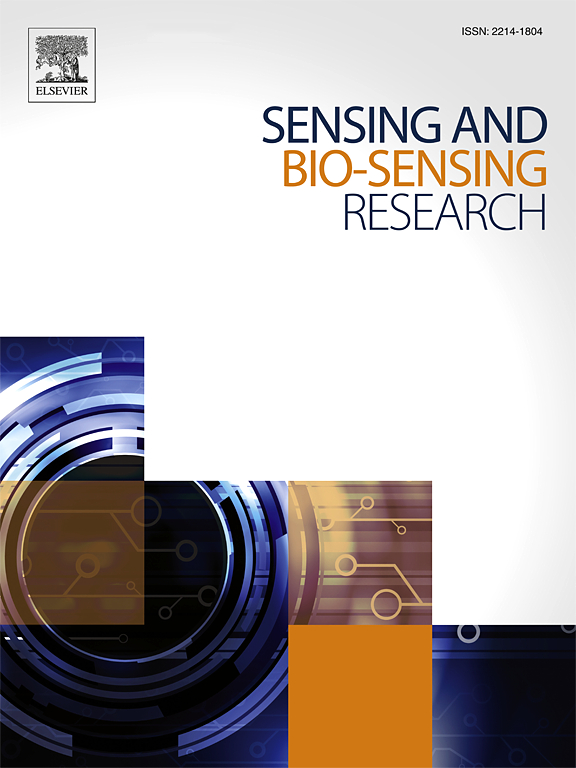DPV and EIS-based ultrasensitive aptasensor for VEGF165 detection based on nanoporous gold platform modified with SH-aptamer
IF 4.9
Q1 CHEMISTRY, ANALYTICAL
引用次数: 0
Abstract
The sensitive detection of trace amounts of vascular endothelial growth factor (VEGF165) in samples holds significant potential for clinical cancer diagnosis across various cancer types. This work introduces a novel and cost-effective dual strategy for developing an ultrasensitive electrochemical aptasensor based on the self-assembly of SH-aptamer onto a nanoporous gold electrode for VEGF165 detection. SEM and electrochemical characterization confirmed the formation of the nanoporous structure and the increase of the surface area of the gold electrode from 0.1199 cm2 to 0.1875 cm2. The sensing method relied on the interaction between the DNA probe and VEGF165, which increased the charge transfer resistance of Fe(CN)63−/4- in the (signal-on) strategy, as determined by EIS. Conversely, it diminished the reduction peak current of the methylene blue probe in the (signal-off) strategy, as assessed by Differential Pulse Voltammetry (DPV). The limit of detection and linear dynamic range of the prepared electrode were found to be 0.25 pM and 2.5 to 140 pM, respectively, using DPV, and 0.18 pM and 5 to 200 pM, respectively, using EIS. The aptasensor demonstrated desirable stability after storing the aptasensor in a buffer solution for one week. Furthermore, analogous proteins did not exhibit significant interference. Also, detecting the VEGF165 cancer marker in undiluted human serum samples had excellent recovery with relatively low standard deviation percentages. Therefore, the findings indicate that the proposed aptasensor could potentially be utilized in the future design of a non-invasive cancer diagnostic kit using a blood or interstitial fluid test instead of the painful and aggressive biopsy method.

基于sh -适配体修饰的纳米孔金平台的DPV和is超灵敏VEGF165检测传感器
样品中微量血管内皮生长因子(VEGF165)的灵敏检测对各种癌症类型的临床癌症诊断具有重要潜力。这项工作介绍了一种新颖的、具有成本效益的双策略,用于开发一种基于sh适体自组装到纳米孔金电极上的超灵敏电化学适体传感器,用于VEGF165检测。SEM和电化学表征证实了纳米孔结构的形成,金电极的表面积从0.1199 cm2增加到0.1875 cm2。传感方法依赖于DNA探针与VEGF165之间的相互作用,这增加了Fe(CN)63−/4-在(信号接通)策略中的电荷转移电阻,如EIS所确定的那样。相反,根据差分脉冲伏安法(DPV)的评估,它降低了亚甲基蓝探针在(信号关闭)策略中的还原峰电流。DPV的检测限和线性动态范围分别为0.25 pM和2.5 ~ 140 pM, EIS的检测限和线性动态范围分别为0.18 pM和5 ~ 200 pM。在缓冲溶液中保存一周后,aptassensor表现出理想的稳定性。此外,类似蛋白没有表现出明显的干扰。此外,在未稀释的人血清样本中检测VEGF165癌症标志物具有较好的回收率,标准偏差百分比相对较低。因此,研究结果表明,所提出的适体传感器可以潜在地用于未来设计一种非侵入性癌症诊断试剂盒,使用血液或间质液测试代替痛苦和侵袭性活检方法。
本文章由计算机程序翻译,如有差异,请以英文原文为准。
求助全文
约1分钟内获得全文
求助全文
来源期刊

Sensing and Bio-Sensing Research
Engineering-Electrical and Electronic Engineering
CiteScore
10.70
自引率
3.80%
发文量
68
审稿时长
87 days
期刊介绍:
Sensing and Bio-Sensing Research is an open access journal dedicated to the research, design, development, and application of bio-sensing and sensing technologies. The editors will accept research papers, reviews, field trials, and validation studies that are of significant relevance. These submissions should describe new concepts, enhance understanding of the field, or offer insights into the practical application, manufacturing, and commercialization of bio-sensing and sensing technologies.
The journal covers a wide range of topics, including sensing principles and mechanisms, new materials development for transducers and recognition components, fabrication technology, and various types of sensors such as optical, electrochemical, mass-sensitive, gas, biosensors, and more. It also includes environmental, process control, and biomedical applications, signal processing, chemometrics, optoelectronic, mechanical, thermal, and magnetic sensors, as well as interface electronics. Additionally, it covers sensor systems and applications, µTAS (Micro Total Analysis Systems), development of solid-state devices for transducing physical signals, and analytical devices incorporating biological materials.
 求助内容:
求助内容: 应助结果提醒方式:
应助结果提醒方式:


